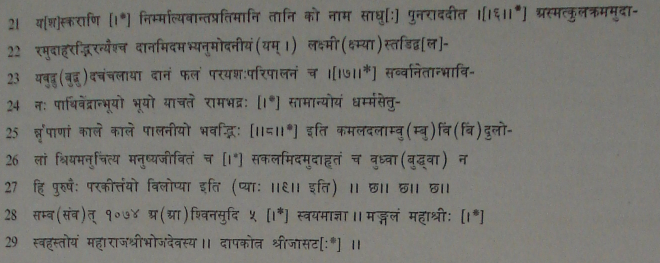|
The Indian Analyst
|
North Indian Inscriptions |
INSCRIPTIONS OF THE PARAMARAS OF MALWA BEṬMĀ COPPER-PLATE INSCRIPTION OF BHOJADEVA
NO. 10 ; PLATE XII ...THE copper-plates on which this inscription is incised are said to have been found by a farmer, in the early years of the present century, in course of ploughing his field near Bēṭmā [1] , a village in the Dēpālpur parganā in the District of Indore in Madhya Pradesh. The inscription was first noticed by the late D. B. Diskalkar, in the Annual Report of the Watson Museum, Rajkot, for 1922-23, page 13; and the same scholar subsequently edited it in the Epigraphia Indica, Volume XVIII (for 1925-26), pp. 320 ff., giving his reading of the text in the Nāgarī alphabet (pp. 322-24), its translation (pp. 324-25) and facsimile plates between pp. 322-23. In the meanwhile the plates were acquired for the Museum at Indore where they are now exhibited. The inscription is edited here from the original plates.
...The plates are two in number, each measuring 33.2 cms. in the length and 22.2 cms. in breadth. They are thick and substantial and do not show the marks of the chisel on the other side. The edges of them were fashioned somewhat thicker than the inscribed surface, with corresponding depressions inside, to protect the writing, which is in a good state of preservation. Both the plates are held together by two rings of copper, each of which is about . 8 cms. thick and approximately 5 cms. in diameter, and passes through one of the two holes bored in the lower margin of the first and the upper margin of the second, with an intervening space of 6.5 cms. Each of first plate, they do not disturb the continuity of the writing. In the lower left side of the plate, in a rectangle about 5.5 cms. broad and 7.3 cms. high, formed by double lines interspaced by oblique strokes ending in acute angles, is the representation of Garuḍa, facing proper left and holding a cobra in the left hand. The weight of the two plates together with the rings is 2.96 klgms. ...Both the plates are incised only on the inner side and the letters are deeply and beautifully formed. The writing covers a space measuring 29.5 cms. broad by 18.5 cms. high but the length of the last five lines is shorter by 6 cms. than of the others as the initial portion of them is occupied by a part of the rectangular area containing the Garuḍa figure as stated above. The first plate contains 13 lines of writing and the second 14 lines, including a separate line of the sign-manual of the king engraved on each in the lower left corner. The average size of the letters is about 1 cm.
...The characters are Nāgarī, prevalent in Mālwā in the eleventh century, bearing a general
resemblance to those of the Bāṅswāḍā plates, edited just below. The initial a appears four times
in 11. 14, 16, 18 and 21 ; of these the last one shows a slight variation from the others which
are as in the Bāṅswāḍā plates. The initial i and the consonants j, bh and ś retain their antique [1] This village is about 20 kms. south-southeast of Dēpālpur and 26 kms. west of Indore. on metalled road from Indore to Dhār. It is also called Beṭmā.
|
||||||||||||||||||||||||||||||||||||||||||||||||||||||||||||||||||||||||||||||||||||
| > |
|
>
|








